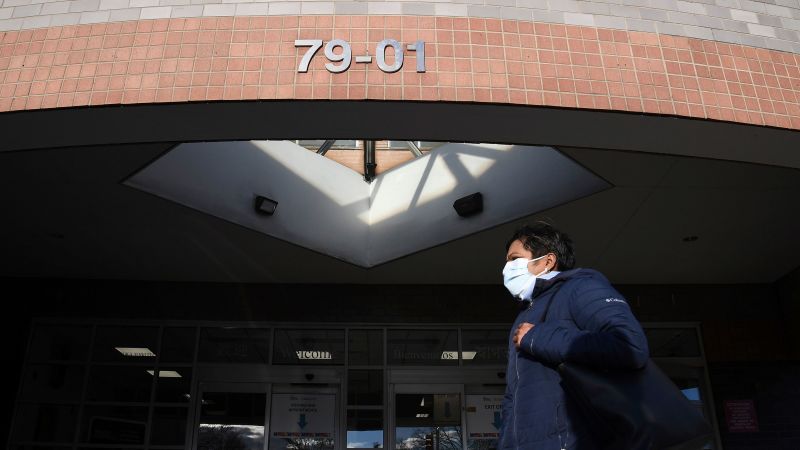The federal government shutdown has brought respiratory virus surveillance to a halt at the national level, leaving local governments, health systems and the general public with critical blind spots as the season starts to ramp up.
Key federal reports on flu, Covid-19 and RSV haven’t been updated in nearly a month, even as virus activity picks up.
These viruses kill tens of thousands of people in the US each year and hospitalize hundreds of thousands more, but they typically follow seasonal patterns and don’t spread as quickly as diseases like measles.
During a shutdown, national disease surveillance reports are updated only if they “protect from imminent loss of life,” said Dr. Caitlin Rivers, an epidemiologist and director of the Center for Outbreak Response Innovation at the Johns Hopkins Bloomberg School of Public Health.
The federal government’s measles response is an “active public health intervention” and permitted by law to continue, according to a statement from the US Department of Health and Human Services, but the shutdown “thwarts the CDC’s ability to continue to publish routine flu data from its public health partners”
The US Centers for Disease Control and Prevention’s general Respiratory Illness Data Channel – which offers insight into viral activity through trends in early warning signs like wastewater surveillance and emergency department visits – was last updated September 26, a few days before the shutdown began. Weekly updates from the more specific FluView have stopped, as have summary reports from RESP-NET that tracks hospitalizations for Covid-19, flu and RSV from a network of hospitals across the country. At that time, flu and RSV were already showing signs of increasing activity and Covid-19 levels were elevated.
According to the latest 2025-26 respiratory disease season outlook from the CDC, the US “will likely have a similar number of combined peak hospitalizations due to COVID-19, influenza, and RSV compared to last season.” Last season, the agency estimates there were between 610,000 and 1.3 million flu hospitalizations and up to 130,000 flu deaths. There were also hundreds of thousands of Covid-19 hospitalizations and between 44,000 and 63,000 deaths.
“For people who manage their health, it’s like weather or traffic reports blinking out,” Rivers said.
In response to questions about how the federal government is working to inform the public about respiratory virus risk and plans to adapt if the shutdown lasts long-term, HHS said the shutdown may delay answers.
“The Trump Administration is committed to reopening the government for the American people. During the Democrat-led shutdown, mission-critical activities at CDC will continue,” the agency said in a statement.
Some information is still being collected by states and reported to the CDC during the shutdown, and it is often made available to the public through state dashboards. But a coordinated national assessment of trends is a necessary part of preparedness, experts say, and that has lapsed.
“The single most important aspect of any response to a problem is communication – clear, sustained communication to the profession and to the general public – and any lack of information impairs that communication,” said Dr. William Schaffner, an infectious diseases expert at Vanderbilt University and spokesperson for the National Foundation for Infectious Diseases.
RSV, for example, follows a predictable pattern each season, experts say: Viral activity starts in the southern part of the country and moves north. Activity is already on the rise in Florida, and two outbreaks were reported in the southeastern part of the state, Rivers noted in her latest newsletter.
Without national coordination, however, other states and local jurisdictions might lack visibility into Florida’s trends and other cues they’ve historically used to plan for their own response.
The severity and progression of each flu season can be quite unpredictable, experts say, but national analysis of data and trends can help make the season’s outlook less blurry.
“It’s the old scouting motto, ‘Be prepared,’” Schaffner said. “The information is so important to everyone in the health care world because it allows hospitals and clinics and emergency rooms to brace for what’s coming. It allows them to anticipate what their staffing needs are, their supplies … and take care of patients in a much more coherent fashion.”
National surveillance also helps capture more comprehensive data on the virus variants that are circulating, he said, which can help raise the alarm about a potentially more severe season if the vaccine isn’t a good match or about the rise of any particularly concerning varieties such as bird flu.
Laboratory testing capacities at the CDC and expert guidance to analyze local trends may also be hampered during the shutdown, experts say. Lack of visibility on emerging threats is of particular concern because of surveillance pauses. Many CDC researchers will also miss IDWeek, the largest annual meeting of infectious disease experts in the nation, because of the shutdown.
Many people have also come to use federal respiratory virus information to manage their own health. Infectious diseases don’t stay within state boundaries, and experts say many folks want a broader view of the situation – particularly if they’re traveling for the holidays.
It can drive some decisions around vaccination, too.
Dr. Anne Zink, former chief medical officer for the state of Alaska, says she knew an epidemiologist who would wait to get the flu vaccine until the data started to show an uptick in activity.
“[Protection from] the flu vaccine doesn’t last for that long, so he would want to get it early enough that it would cover him for the season but late enough that it wouldn’t run out before the end of the season,” she said. “So he was always in this space that data needs to be accessible and available to everyone to be able to make that decision.”
Although the process may be more complicated and less thorough, it’s still possible to get a read on respiratory virus trends.
The necessary state and local groundwork to track viruses is continuing, and state health departments are still updating respiratory virus dashboards. Rivers has started compiling all of the publicly available data into her newsletter each week.
Zink recently helped launch the Population Health Information and Visualization Exchange, or PopHIVE. Hosted by the Yale School of Public Health, the platform brings public and private health datasets together for a more comprehensive and real-time look at a wide range of health trends than was available before.
“For a long time, the government hasn’t been doing exactly what we needed it to do,” Zink said. “This is a filling a gap that’s existed long before a shutdown, and it’s just now maybe getting a little more attention because of that.”
With many pathogens, a brief lapse in surveillance – as due to a government shutdown – is manageable, said Dr. John Brooks, an infectious disease physician and expert in HIV prevention who previously served as chief medical officer for CDC’s Emergency COVID-19 Response.
“There may be a period of delay, there may be a hiccup here or there, but generally it continues. We catch up,” he said.
But in the meantime, some data and surveillance problems can’t be fixed by cobbling various sources together.
“As a general principle, the places where you’ll see problems arising first are in those pathogens that are transmitted most quickly and spread most rapidly,” Brooks said.
Measles outbreaks continue to cause dozens of cases each week in the US, and the CDC has maintained weekly data reporting accordingly.
Flu can also spread quickly, which makes “the need to be on top of the data even more acute” than for something like HIV, Brooks said.
But there’s a deeper concern about losing visibility on certain groups that are most affected by particular pathogens because of broader policies of the Trump administration. Soon, transgender people will no longer be reported in federal surveillance for HIV, despite having one of the highest diagnosis rates.
Recently formed groups such as the West Coast Health Alliance and the Northeast Public Health Collaborative — in which state health departments have banded together to issue public health guidance separate from the CDC — may be a “needed second perspective” when it comes to tracking disease, Brooks said.
While the work of the groups has been more focused on counterbalancing flawed guidance and policy from the CDC, Brooks said, forming these relationships now also puts them “one step ahead” if the need arose to fill gaps in data surveillance.
In all cases, though, surveillance data creates “that fidelity of information to make sure that you are not missing where problems occurring, and so that you can bring the resources necessary to those persons to protect them and take care of them,” Brooks said.
Experts say that a pause in respiratory virus surveillance was an expected consequence of the government shutdown. Once it’s over, though, the actions the government prioritizes to ramp reporting back up will be important to watch.
“When there’s a shutdown, the catchup is really expensive, so things don’t tend to come up very quickly,” said Dr. Demetre Daskalakis, who recently resigned as director of the CDC’s National Center for Immunization and Respiratory Diseases. “They tend to take a little bit of lead time because of the need to catch up on whatever’s been left behind.”
The time needed for that catchup is exacerbated by broader turmoil at the CDC, he said.
According to estimates from a local union representing federal workers, about a quarter of the CDC’s workforce – about 3,000 workers – have been fully separated since the beginning of the year. Additional attempted reductions in force, or RIFs could effectively bring cuts to the agency up to a third.
Employees of the National Center for Immunization and Respiratory Diseases are among the hundreds of CDC workers who were recently fired in error and reinstated the next day.
And the Trump administration could use the shutdown as a strategy to delay certain reporting – such as data around vaccine uptake – even longer, Daskalakis said.
“National Immunization Survey data as well as other data streams that people tend to look at to see what’s happening with vaccine coverage are also hampered by the shutdown,” he said. Seasonal vaccination coverage is already off to a slow start because federal Covid-19 vaccine recommendations came later than usual.
“It makes me concerned that [the administration] may not prioritize that, so we won’t have visibility into what’s happening on the national point of view for vaccine coverage late into the season,” Daskalakis said.
As public health struggles with trust in the US, experts say that access to timely, accurate data is critical.
“To deal with an outbreak in the most successful fashion, you have to be able to communicate the latest information quickly to both medical professionals and medical institutions and to the general public,” Schaffner said. “If you don’t have the information, the communication becomes much less precise and much less useful, and that may feed the mistrust, concern and questions that the public has already about the public health system.”
CNN’s Meg Tirrell contributed to this report.
First Appeared on
Source link












